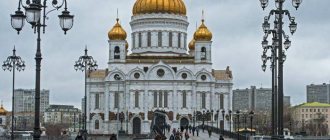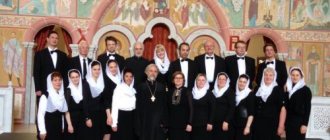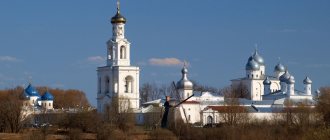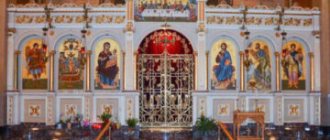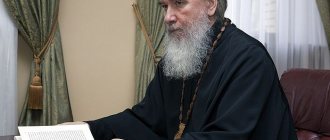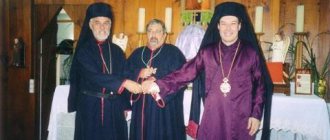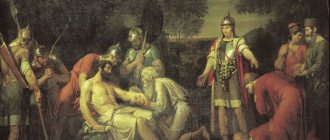A powerful scandal rocked Orthodox Christianity this week. A new church schism is brewing. Due to disputes about the status of the Ukrainian Orthodox Church and its dependence/independence on the Moscow Patriarchate, the Russian Orthodox Church broke off all relations with the Patriarchate of Constantinople, which is headed by the “first among equals” in Orthodoxy, Ecumenical Patriarch Bartholomew. Now there are no joint services, and Orthodox Christians loyal to the Russian Orthodox Church are prohibited from praying in churches controlled by the Patriarchate of Constantinople.
All participants in the conflict and outside observers understand: religion has nothing to do with it, the matter is heavily involved in politics. This, however, has always been the case with church schisms. And the Great Schism of almost a thousand years ago, which divided Christianity into Catholicism and Orthodoxy, is no exception.
Paul's Hopeless Call
Already in the letter to the Corinthians 54-57. The Apostle Paul warned the first Christians against fighting among themselves: “I hear that when you gather together for church, there are divisions among you.” And this was at a time when the main concern of Christians was the desire not to end the day on spears or in the teeth of a lion (until the 4th century, Christianity in the Roman Empire was considered a dangerous heresy). It is not surprising that as the church transformed from a persecuted and embattled sect into a powerful and wealthy institution, the number of divisions within Christians only increased.
In 313, the Emperor of the Roman Empire Constantine the Great legalized Christianity, whose popularity grew steadily over three centuries, and Emperor Theodosius in 380 made the teachings of Christ the state religion. The problem is that after Theodosius, the once united Roman Empire split into the Western (Roman itself) and Eastern (with its capital in Constantinople). After this, the division of Christianity into two branches became a matter of time. But why?
The development of two churches in the 5th-11th centuries and the division of Europe
The Eastern Church relied on state power, while the Western Church sought to rise above it. The concept of the papacy was based on stricter discipline and hierarchy. The Western Church has arrogated to itself the right of the highest court and monopoly mediation between God and people.
Under Pope Gregory I (590-604), who organized the defense of Rome from the Lombards and actually saved it, the “Eternal City” finally became the residence of St. Peter, and the popes were proclaimed his successors. At the same time, Gregory I defiantly called himself “the servant of the servants of God,” contrasting his humility with the luxury of the Patriarch of Constantinople.
The energetic and ambitious Gregory I initiated active missionary and diplomatic activities. As a result, the Visigoths, Lombards, tribes of the Iberian Peninsula, as well as some tribes of the Angles and Saxons converted to Catholicism. The Holy See maintained relations with most European rulers.
During the time of Charlemagne the position of the Western Church was strengthened. In 800, the pope personally placed the imperial crown on the head of the Frankish king, which became a symbol of the supremacy of the church over secular power. In turn, Charles needed to strengthen the empire not only through the sword and the law, but also through spiritual and religious unity. In the person of the Frankish kings, the papacy acquired defenders, and the Carolingians received confirmation of the legitimacy and inviolability of their power.
Subsequently, the doctrine that kings are only an instrument in the hands of the church became widespread. The Holy See perceived state affairs as its own, and Pope John III even declared that he had the right to both crown and remove rulers. Reinforcing the theocratic ambitions of the papacy was the “Donation of Constantine,” a document fabricated in the 8th century, according to which Constantine the Great allegedly granted the pope supreme power in Italy and supremacy over Christianity.
The highest power in Byzantium was closely connected with Christianity. Basileus, as a rule, had an excellent understanding of theology and could participate on equal terms in theological disputes. Synods could not act bypassing the ruler, while sovereigns could issue decrees regarding the religious sphere of society.
The Eastern Church was weakened by the struggle between two religious trends - iconoclasm and icon veneration. Rome tried to use the differences within the Eastern Church to its advantage, but in the end the basileus, no matter how they treated the icons, did not allow the church to get out from under their dictate.
East: Is the Second Rome superior to the First?
The emperor in the Roman Empire had absolute power, including over Christianity: it was Constantine who convened the First Ecumenical (Nicene) Council, which established the fundamental dogmas of Christianity, such as the concept of the Holy Trinity. In other words, the highest clergy was subordinate in everything to the man on the throne.
While the emperor remained alone at the pinnacle of power, everything was relatively simple - the principle of unity of command was preserved. After two equal centers of power were formed, the situation became sharply more complicated. Especially after Rome collapsed under the onslaught of barbarians (476), and political chaos reigned in Western Europe for a long time.
The rulers of the Eastern Roman Empire, which we know as Byzantium, positioned themselves as the heirs of the empire, including in terms of power over the church. Constantinople unofficially acquired the status of the “second Rome” - the capital of world Christianity.
West: Heirs of the Apostle Peter
Apostle Peter
Meanwhile, in real Rome, which was going through hard times, the Christian clergy was not going to lose primacy in the world of believers. The Roman Church felt special: in addition to the partially lost capital position, it claimed special rights that went directly back to Christ.
“You are Peter, and on this rock I will build my church,” Jesus says in the Gospel of Matthew to his disciple Peter (whose name means “rock”, even in the Holy Scriptures there is a place for a play on words). The Roman bishops interpreted this quote quite unambiguously: the Bishop of Rome, the Pope, is the successor of Peter, who preached and was martyred by the pagans in Rome, which means that it is Rome that should rule the entire Christian Church.
In Constantinople, they preferred to gently ignore such an interpretation. This inconsistency regarding the issue of supreme power became a time bomb for Christianity. Long before 1054, the number of dogmatic disputes between the Greek-Byzantines and the Latin-Romans grew: for about 200 years in the 4th-8th centuries, the churches alternately interrupted and then resumed communication.
Perhaps the greatest blow to the unity of the church was the crowning of Charlemagne as Holy Roman Emperor in 800. This directly offended Constantinople and finally destroyed the formal unity of the empire. However, Pope Leo III, who crowned Charles, can be understood: Charles may be a Frank by birth, but he is a great commander and can guarantee the protection of the papal throne here and now, while the Greeks are solving their own problems somewhere far away.
The beginning of the confrontation between the Western and Eastern churches
From the very beginning, the Christian Church declared itself as a world religion, but lost its monolithic character almost immediately after it began to be introduced into society. Already in the second half of the 2nd century, the Latinization of the church began in North Africa, while in Rome itself for another century the main language in the church environment was Greek. This was the beginning of the divergence between the Western and Eastern directions of Christianity, which then only deepened.
The Council of Nicea showed that the eastern hierarchs of the church (Basily the Great, Gregory of Nazianzus, Gregory of Nyssa) looked down on the theological reasoning of their Western “colleagues”, the largest of whom at that time were Jerome of Stridon and Aurelius Augustine. They, in turn, categorically disagreed with this state of affairs and in 343 at the Council of Sardica declared their supremacy over the entire Christian Church.
Essentially this meant the division of the church. In 451, the Council of Chalcedon recognized the Patriarchs of Constantinople and Rome as equal in status - the heads of regional Christian movements. Despite this, Europe remained an arena of rivalry between rulers, each of whom laid claim to universal power.
A short list of controversies
By 1054, the Greeks and Latins had accumulated difficult questions for each other. The most important is the disagreement described above regarding the status of the Pope: is he the head of the Universal Church (as Rome believes) or only the first among equal bishops (as Constantinople believes)? As you can understand today, this was the main question. It was not only about religious, but also about political power over believers.
The main theological contradiction is the so-called Filioque formula (Filioque - “from the Son”). Over time, Western tradition established that in the Christian Trinity the Holy Spirit emanates not only from God the Father, but also from God the Son (Jesus), while Eastern Christians traditionally relied on more ancient sources that claim that the Spirit emanates only from Father. For Christians in the Middle Ages, this was more than a fundamental issue, and the mere thought of including the Filioque in the Creed caused great indignation among Eastern Christians.
Of course, there were also a number of smaller, ritual contradictions between the two branches of Christianity.
For example, Eastern Christians allowed priests to marry, while celibacy was mandatory for all Western Christians. Western Christians fasted on Saturday during Lent, but Eastern Christians did not. The Roman Church allowed the use of unleavened, unleavened bread in the sacrament of communion (liturgy on unleavened bread), but this outraged the Eastern churches, which accused the papists of almost returning to Judaism. Quite a lot of such everyday differences have accumulated. And, since in the Middle Ages people attached much more importance to rituals, everything was very serious.
Failed embassy
Pope Leo IX
What exactly happened in 1054? Pope Leo IX sent an embassy to Constantinople. His goal was to mend relations that had become increasingly tense in recent years: the influential Patriarch of Constantinople, Michael Cerularius, sharply resisted attempts by the Latins to impose their theocracy in the east. In 1053, the warlike Michael even ordered the closure of all churches in the city that served according to the Latin model: the Latins were expelled, and some particularly indignant Greek priests kicked the bread prepared for the Eucharist.
Patriarch of Constantinople Michael Cerularius
It was necessary to resolve the crisis, but it only turned out to worsen: the embassy was headed by Cardinal Humbert Silva-Candide, as irreconcilable as Michael. In Constantinople, he communicated mainly with Emperor Constantine Monomakh, who politely received him, and even tried to persuade him to remove the patriarch, but to no avail. Humbert and the two other legates sent with him did not even speak to the patriarch himself. It all ended with the cardinal, right at the service, presenting Michael with a papal letter about the deposition and excommunication of the patriarch from the church, after which the legates left.
Michael did not remain in debt and quickly convened a council, which anathematized the three legates (one of whom later became Pope) and cursed them. This is how the church schism took shape, which later came to be called the Great Schism.
A Brief History of the Western Church.
Christianity originated in the Roman Empire, after the descent of the Holy Spirit on the apostles: Peter, Andrew, John, James Alphaeus, Judas, Bartholomew, James Zebedee, Levi Matthew, Philip, Simon the Zealot, Thomas, but it was adopted as a state religion by decree only in 380 Emperor Theodosius I. The first five churches appeared: Jerusalem, Antioch, Alexandria, Constantinople and Rome. Initially, the apostles became the preachers of the Christian religion. Rome at that time was the capital of the new faith. Before the advent of Christianity, polytheism, Zoroastrianism, totemism, etc. reigned. The Roman Empire was a developed state and occupied a large territory from the Middle East to England; from southern Europe to northern Africa. The people inhabiting the Roman Empire practiced polytheism. During 300
Christians were persecuted for years until
313
.
In 313
, the Roman Emperor Constantine I issued a decree on the liberation of Christians and freedom of religion.
In 476
, the Western Roman Empire fell to the onslaught of barbarian tribes and the city of Constantinople became the new capital of the church.
Until 1453
, Constantinople remained the center of the Christian world, until it was captured by Turkish troops.
The Roman Catholic Church, founded in the 1st century, is the founder of the Western Church. It spread throughout Europe during the first millennium. The history of the Western Church covers a period of 2000
years.
The influence of the church expanded throughout the entire territory of the former Roman Empire. After the collapse of the Roman Empire, a period of time begins, which in history is usually called the “Dark Ages,” ending in 1000. the formation of modern European states such as France, Germany, etc. It was during this period of time that the foundations of Christianity were laid. Missionary monks became preachers of religion, baptizing the pagan tribes of the Jutes, Angles, Saxons, Franks, Celts, Vandals, Lombards, Huns, Ostrogoths, and Visigoths. The barbarian tribes gradually became Christianized. The Western Church has fought many wars. In 711
, the Arabs landed on the Gibraltar Peninsula and founded the Emirate of Cordoba.
In order to fight the invaders and to prevent the Arabs from advancing further into Europe, the Pope announced the Reconquista program, during which the Arabs were expelled from the peninsula. In 752
, King Pepin the Short founded the first papal state, the successor of which is the current Vatican.
The state was sovereign. The Pope had claims to full power in the church, but Patriarch Michael of Cerularia (Church of Constantinople) rejected the claims. As a result, in 1054
, Pope Leo anathematized the Patriarch of the Church of Constantinople, Michael of Cerularia.
This caused a split in the church into the Roman Catholic and Orthodox. The 11th-13th centuries are characterized by the Crusades for the liberation of Jerusalem, organized by the Popes. There are 9
great crusades:
1095-1099
.
– the struggle for the preservation of the Byzantine Empire, the result was the founding of the “Latin Kingdom of Jerusalem”; 1147-1149
_
the campaign was organized to capture Jerusalem, but the goal was not achieved; 1189-1191
_
another campaign to capture Jerusalem, which also ended in failure; 1212
so-called Children's campaign was not successful;
1217-1221
_
another unsuccessful Crusade; 1228-1229
_
temporary seizure of power in Jerusalem; then there were three unsuccessful Crusades of 1248-1254
, 1270,
1271-1272
.
This is not a complete list of the Crusades; there were also several smaller campaigns. In 1453
, the Byzantine Empire fell under the onslaught of the Ottoman Turks, and the Church of Constantinople, the ancestor of the Russian Orthodox Church, ceased to exist.
Many clergy fled to Rome, which contributed to the beginning of the “Renaissance” of the 14th-
16th centuries.
The era of the “Renaissance” is characterized by the growth of cities, the influence of classes increases: workers, merchants, etc. New centers of science and art have appeared. In 1517
, the beginning of the “Reformation” of the church, the emergence of Protestant movements, and as a result of the Protestant movement, Protestant churches were formed: Lutheranism, Calvinists, Anabaptists, Anglicanism, Unitarianism, Baptists, Quakers, Presbyterians, etc.
The Roman Catholic Church in turn split into Catholic and Protestant. The reason for the “Reformation” was the desire of the clergy, led by the monk Martin Luther, to reconsider the activities of the Catholic clergy in connection with the accusation of seeking profit and enrichment at the expense of faith. From the above it follows that Protestants are the same Christians as Catholics who wanted the Reformation. There are a number of differences between Catholics and Protestants. The most important difference is that the Catholic Church is headed by the Pope, while Protestants are not united to this day. The Pope is the head of the Catholic Church. Initially, this title was applied to all bishops, and only from the 7th
century to the present day was the rank given only to the head of the Roman Church.
The head of the Catholic Church is elected after the death of his predecessor by an assembly of cardinals for a life term. The 19th century marked the weakening of the power of the Western Church. There was a separation of church and state, church and culture. Missionary activity takes on the first role. The clergy were looking for a way to interact with a new culture and a new society that placed rational science at the center. This contributed to the unification of the church, Rome strengthened its influence. After the discovery of America, Pope Gregory XV
created the Congregation for the Propagation of the Faith, the main purpose of which was the baptism of the indigenous population. This contributed to the further spread of Christianity. The 20th-19th centuries in the history of the Western Church were marked by the revival of the pilgrimage tradition to holy places: Jerusalem, Lourdes, Fatima, Czestochowa, Rome, etc.
Long story
The mutual excommunication in 1054 had a rather symbolic meaning. Firstly, the papal legates excommunicated only Michael and his entourage (and not all the Eastern churches), and he himself excommunicated only Humbert's associates (and not the entire Latin Church and not even the Pope).
Secondly, with a mutual desire for reconciliation, the consequences of that event could be easily overcome. However, for the reasons described above, no one needed this anymore. Thus, quite routinely, not the first, but the most significant split in the Christian Church in history occurred.
Church schism

